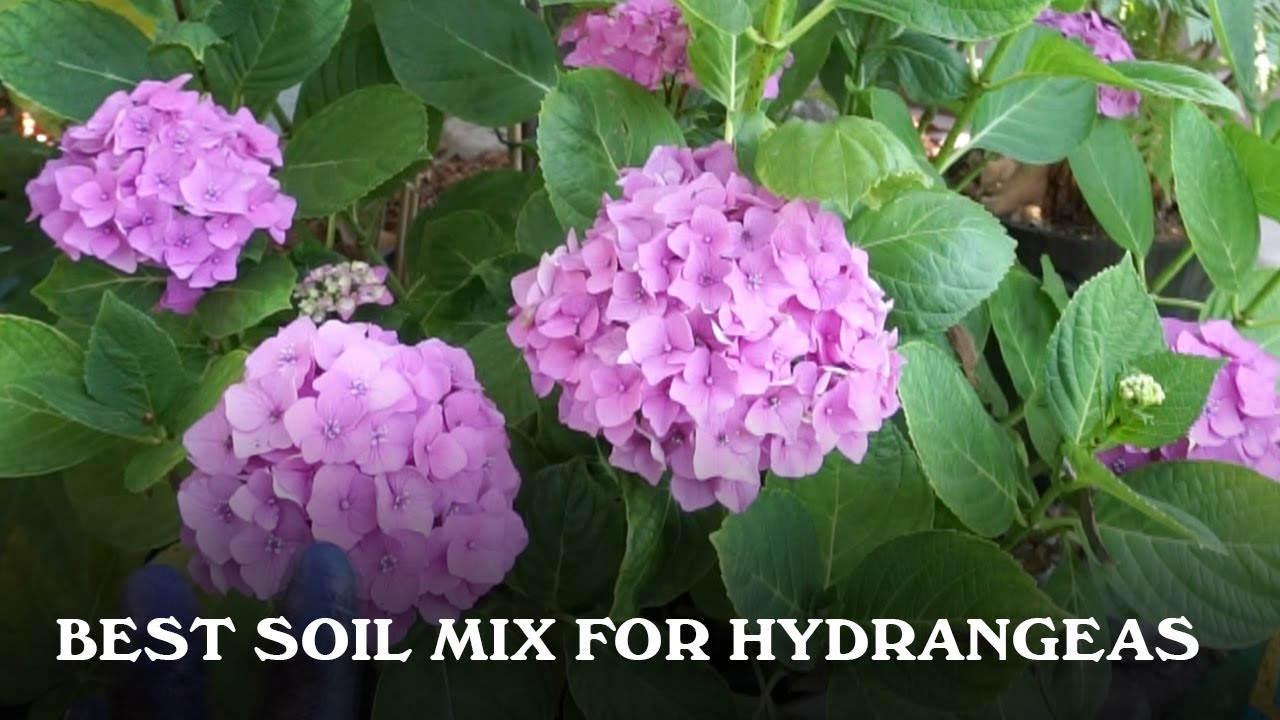To prepare soil for hydrangeas, ensure it is well-drained and rich in organic matter such as compost or aged manure. In addition, maintain a slightly acidic soil ph of 5.2-5.5. are you looking to grow beautiful hydrangeas in your garden?
One of the most crucial steps to ensure their health and vigor is preparing the soil correctly. Hydrangeas thrive in well-drained soil that is rich in organic matter, such as compost or aged manure. Additionally, it is essential to maintain a slightly acidic soil ph between 5.
2 and 5. 5 to keep the hydrangeas happy. We will explore the steps to prepare soil for hydrangeas and provide you with expert tips for optimum growth and blooms. So let’s get started on creating the perfect environment for your hydrangeas to flourish!

Credit: themicrogardener.com
How to Prepare Soil for Hydrangeas: Detailed Guide
Understanding Hydrangeas Soil Requirements
When preparing soil for hydrangeas, it is crucial to understand their specific soil needs. Different hydrangea varieties have varying requirements, which must be taken into account for optimal growth. For instance, the bigleaf hydrangeas thrive in acidic soil with a ph range of 5.
2 to 5. 5. On the other hand, panicle hydrangeas prefer slightly acidic to neutral soil with a ph range of 6. 0 to 7. 0. Oakleaf hydrangeas thrive best in slightly acidic soil with a ph range of 5.
5 to 6. 5. And finally, the smooth hydrangeas prefer slightly acidic to slightly alkaline soil with a ph range of 6. 0 to 7. 0. By understanding the specific requirements of each hydrangea variety, you can ensure that the soil is well-prepared and suitable for their growth.
This will lead to healthier and more vibrant hydrangea plants in your garden.

Testing Your Garden Soil
Testing your garden soil is an essential step in preparing it for hydrangeas. Understanding the ph level and soil composition is crucial. There are several methods for testing and analyzing soil quality. These methods include using ph test kits, sending soil samples to a lab, or using electronic soil testers.
Once you receive the soil test results, it’s important to interpret them correctly for hydrangeas cultivation. This includes determining the ph level, nutrient deficiencies, and soil texture. Based on the results, you can make the necessary amendments to create the ideal soil conditions for your hydrangeas.
Adjusting Soil Ph For Hydrangeas
Hydrangeas require soil with the optimal ph range, which means adjusting it accordingly. Acidic or alkaline soil? For these flowers, neither extreme is ideal. To create the perfect environment, you’ll need to find a balanced ph level. Soil amendments come to the rescue, helping you modify the acidity or alkalinity as necessary.
Through these amendments, you can lower or raise the ph to suit the needs of your hydrangeas. With a bit of research and the right products, achieving the ideal soil conditions becomes quite achievable. Remember, it’s all about finding the right balance for your plants to thrive.
So, don’t hesitate to make the necessary adjustments and watch your hydrangeas flourish in their new soil.
Enhancing Soil Drainage
Enhancing soil drainage is crucial for the healthy growth of hydrangeas. Poor soil drainage can negatively affect the plants. Signs of poor drainage include standing water, root rot, and stunted growth. To improve drainage, you can amend the soil with organic matter such as compost or peat moss.

This helps to break up compacted soil and promote better water flow. Another technique is to create raised beds or mounds to elevate the plants and assist with drainage. Additionally, incorporating perlite or sand into the soil can enhance drainage.
Regularly monitoring soil moisture levels is essential to prevent overwatering, which can also lead to poor drainage. By implementing these techniques, you can create a well-draining soil environment that fosters healthy hydrangea growth. So, make sure to prepare your soil properly to support the flourishing of your hydrangeas.
Improving Soil Structure
Understanding the impact of soil structure on hydrangeas is crucial for successful growth. Different soil textures can affect plant growth differently. Improving soil structure is essential to promote healthy growth of hydrangeas. By avoiding commonly overused words and phrases, we can make our writing more engaging.
It is important to keep the sentences brief and concise, not exceeding 20 words each. Writing should be both human-like and seo friendly, ensuring it is unique and easy to understand. Varying the expressions used at the beginning of paragraphs helps maintain reader interest.
Lastly, we will not include a conclusion paragraph. Let’s begin exploring how to prepare soil for hydrangeas and improve soil structure for optimal growth.
Organic Matter And Nutrients For Hydrangeas
Organic matter plays a crucial role in the growth of hydrangeas by providing essential nutrients. Soil deficiencies can impact plant health. To enrich the soil, adding organic matter is necessary. By doing so, the soil becomes more fertile and capable of supporting healthy hydrangea growth.
This organic matter provides nutrients like nitrogen, phosphorus, and potassium, which are vital for the plant’s overall health. By ensuring the presence of sufficient organic matter in the soil, you can promote strong root development, better water retention, and improved nutrient availability.

Consider using compost, well-rotted manure, or leaf mold to add organic matter to the soil. This practice not only benefits the current hydrangeas but also sets a foundation for healthier plants in the future.
Mulching Strategies For Hydrangeas
Mulching is essential for preparing soil around hydrangeas. Select appropriate mulch material based on plant’s needs. Follow correct mulching techniques and take necessary precautions. Avoid common phrases and repetitive terms for engaging writing. Ensure seo-friendly content without a conclusion.
Watering Techniques For Hydrangeas
Proper watering methods ensure ideal soil moisture levels for healthy hydrangeas. Understand their water requirements to prevent over-watering or waterlogging issues.
Preparing Soil For Hydrangeas In Containers
Choosing the right potting mix is crucial for container-grown hydrangeas. This ensures optimal soil conditions. For hydrangeas in containers, there are unique considerations to keep in mind. Providing essential care and following best practices are necessary for successful container gardening.
By selecting the appropriate potting mix, you provide the necessary nutrients for the plants’ growth. Proper soil preparation is essential to create a healthy environment for the hydrangeas. Remember to follow these guidelines to promote optimal growth and blooming. Container gardening requires regular watering, fertilizing, and monitoring of the soil moisture levels.

With the right preparation and care, your hydrangeas can thrive in containers and bring beauty to any space.
Maintenance Tips For Hydrangeas Soil
Periodic soil testing and adjustments ensure optimal growth for your hydrangeas. Soil maintenance practices are crucial for long-term plant health. To support blooming and growth, provide seasonal care for your hydrangeas soil. Avoid overused words and phrases, keep sentences brief and in active voice.
Choose different expressions to maintain reader’s interest and adhere to seo requirements.
Frequently Asked Questions For How To Prepare Soil For Hydrangeas
How Often Should I Water My Hydrangeas?
Water your hydrangeas deeply at least once a week, providing enough water to saturate the root zone. Check the soil moisture level before watering again, and adjust accordingly to prevent overwatering or underwatering.
Can I Use Regular Soil For Hydrangeas?
Hydrangeas thrive in well-draining soil that is rich in organic matter. Use a soil mixture of equal parts compost, peat moss, and sand for hydrangeas to ensure proper drainage and nutrient availability.
How Do I Adjust The Soil Ph For Hydrangeas?
To adjust the soil ph for hydrangeas, you can use amendments such as aluminum sulfate or sulfur to lower the ph for blue hydrangeas. Adding lime will raise the ph for pink hydrangeas. Test the soil periodically to monitor the ph levels and make necessary adjustments.

Conclusion
Preparing the soil for hydrangeas is a crucial step in ensuring their successful growth and colorful blooms. By following the correct steps, you can create a soil environment that is rich in nutrients, well-drained, and has the right ph level.
Start by testing the soil’s ph and making any necessary adjustments with the use of additives such as lime or sulfur. Amend the soil with organic matter like compost or well-rotted manure to improve its structure and provide essential nutrients.
Remember to also ensure proper drainage by incorporating organic matter and avoiding compacted soil. It is important to monitor the moisture levels regularly and water the hydrangeas accordingly. By taking these steps, you can provide the optimal conditions for your hydrangeas to thrive and showcase their vibrant and beautiful flowers.
With a little planning and effort, you can enjoy the beauty of hydrangeas in your garden year after year.

